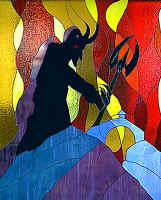Carnival Characters
The Devil
The Devil, also called Satan or Beelzebub, has three different names and is the most important character of the Pont-Saint-Martin Carnival. The person who represents the Devil (mocked by Saint Martin) wears a red and black dress, a cap with two horns, a long creeping tail, and a red and black cloak; and he holds a trident. The Devil has an agitated, nervous and furious behaviour which contrasts with the kind, friendly and peaceful Saint Martin.
During the parades the Devil runs among the spectators shouting and laughing and causing chaos!
He likes bean soup because of its characteristic of causing flatulence. During Carnival balls he bothers the Nymph, the maidens and all the ladies.
During the final torchlight walk everybody looks for him. He should arrive in the middle of the Roman bridge and shout while the puppet which represents the Devil is burning under the bridge.
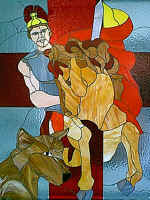 Saint Martin
Saint Martin
Saint Martin has played a leading role in our Carnival since 1910. He is the enemy of the Devil and they are both very active from Saturday to Shrove Tuesday night. They represent the legend about the construction of the Roman bridge in Pont-Saint-Martin.
However , the character of Saint-Martin also has an important historical meaning. He wears the Roman military uniform which is a reminder of his past as a soldier. He has a sword but he does not use it. He greets the crowd with blessing gestures and he is a kind and polite character. During the parades he looks friendly and peaceful and he does not react to the Devil’s provocations.
The Lys Nymph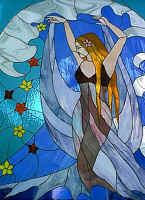
Since 1952 the Lysnymph has been the most beloved Carnival character. The fairy of Colombera (Réchanter) in the legend is a beautiful fairy who lived near Réchanter. She became good at the end, when the people of Pont-Saint-Martin asked her to leave them the Roman bridge, which she did.
The lady who represents this character is usually kind, friendly and elegant and when people during Carnival Parades shout “Viva la Ninfa” (Hooray for the Nymph) she throws them mimosa flowers and candies. She usually wears a waving dress with the colours of the Lys water. Together with the two maidens she sits on a float (drawn by our artist Cristiano Nicoletta) surrounded by waves. She should always smile even though the weather is not always mild or there are other problems; and she has the most important role during the balls, including the kids masked ball. The Lysnymph must be beautiful and her name must be kept secret until the Saturday evening.
Representing the Lysnymph is an exclusive life experience. On the Saturday evening when the floodlights light up the stage and the magistratus (speaker) announces to all the inhabitants of Pont-Saint-Martin the name of the lady, everybody feels high emotion and the Nymph lives her moment of glory.
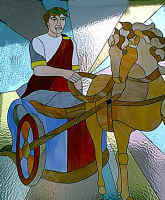 The Roman Consul
The Roman Consul
The Roman Consul is a very important character in the Carnival. He made his first appearance in 1910. The character does not represent any particular Roman Consul, although some think he should represent Appio Claudio Pulcro, who fought against the Celtic tribe of Salassi in 143 B.C.
The person who represents this character must wear clothes relating to the Ancient Roman era, such as a white toga and a purple cloak.
During the Carnival Parade he crosses the streets on his biga and salutes to the crowd. He is always smiling and with his noble appearance commands the Roman Soldiers, the guards and the tribunes. He is always a gentleman with the Nymph.
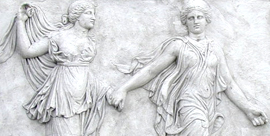 The two Nymph Maidens
The two Nymph Maidens
The two Nymph Maidens were added in 1954. They were created to help the Nymph and to not to let her be the only lady among the many male characters in the Historical Carnival parade. They also help the Nymph during parties and parades. According to the tradition they are unmarried, pretty young girls who represent the young ladies of the village. The Nymph Maidens wear wavy dresses which remind us of the Lys water. During the parades they sit with the Nymph on a float surrounded by waves and they help her to distribute candies and mimosa flowers to the people. At the ball they receive many invitations to dance which they should not refuse. They are very popular among people their age.
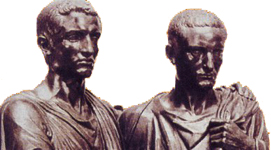 The Tribunes of the people
The Tribunes of the people
The Tribunes of the people have been historical characters in our Carnival since 1958. Their role is based on the Ancient Roman era and connected to the real Story of the bridge. They are usually four men who drive a biga; they smile and greet the people watching the Carnival. They must be well behaved at all times. Because they represent the people, they are on hand during the ceremonies and the balls, and they escort the Roman Consul, the Nymph and the two maidens. The Tribunes wear a white toga and they march bareheaded they march with great propriety.
The Chief of the Guards and the Roman Guards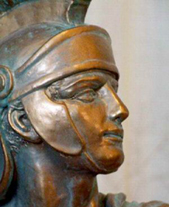
The Chief of the Guards is a character who was created in 1910 specifically for our Carnival. During the Roman era our Roman bridge was guarded 24-7. The Guards controlled the bridge from a watchtower. The chief of the Guards was responsible for the bridge; he normally had four Guards working under him. Like the Guards teh Chief wears Roman armour with a helmet and red cloak.
In the first Carnival after War World II the Chief of the Guards was called “Legione” and his Guards “Legionari”.
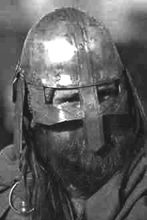 The "Salassi"
The "Salassi"
(local Celtic population)
The first year the Salassi appeared at the Carnival was 1976. This was for the first challenge between the Ancient Roman people and the local Celtic population. The Salassi are represented by a group of robust men and women, with long hair, suits of a simple make, and furry footwear. They march in a coarse way and, compared to the Roman soldiers, tribunes and guards they look like a horde of Barbarians. They like food and wine and their best weapons are, spoon, fork and knife!
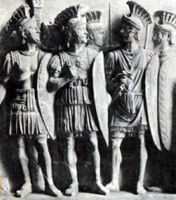 The Roman Soldiers
The Roman Soldiers
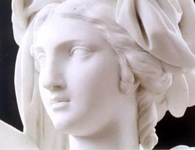 The Roman Maidens
The Roman Maidens
In recent years the parade was enriched by the addition of a group of Roman Maidens. They wear a simple Roman dress with a blue, purple or green cloak. The Roman characters of our Carnival were, previously, mostly men, so a group of young women was added to represent the gentle sex.
The Senators
In 1990 a new character was introduced to our Carnival with a role of making awards to people, authorities and associations who made a particular contribution to the development and improvement of our Carnival.
Every year a person is appointed to become the new long life Senator of the Carnival and he/she can take part to the most important events and meetings.
Passages extract from the book:
L. PRAMOTTON - S. MINIOTTI
Il Diavolo e San Martino
Musumeci Editore, 1988










